Can Cities Save Nature?
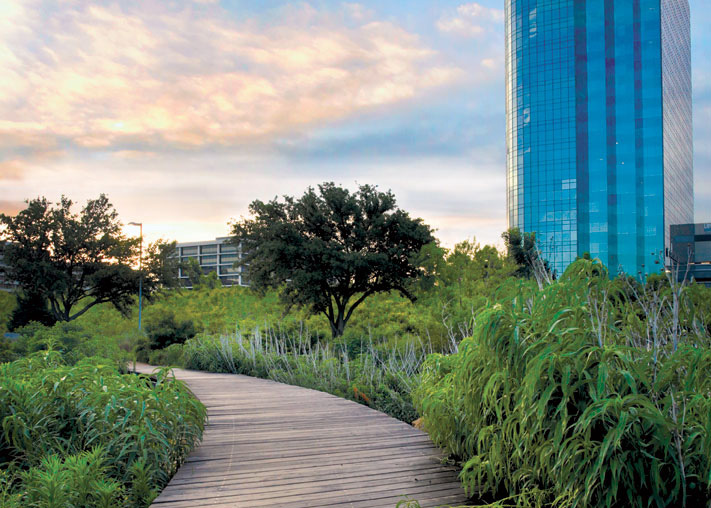
In the designed urban ecosystem at the George W. Presidential Center in Dallas, a bridge flanked by native plants extends over a bioswale that funnels rainwater into a cistern used for irrigation. PHOTO John W. Clark
FOR DECADES, the San Antonio River south of the city’s downtown flowed through concrete channels and between shores covered in Johnson grass, its eight miles channelized – straightened and cleared of vegetation – to control flooding.
A few years ago, after eight years of effort, this portion of river became the Mission Reach Ecosystem Restoration and Recreation Project, a 334-acre riparian woodland made up of 20,000 trees and shrubs representing nearly 100 species of native trees, grasses and wildflowers. This vegetation attracted birds and butterflies in droves, and its roots helped stabilize the riverbanks. Kayakers took to the water, and hikers and bicyclers showed up on a riverside trail connecting five historic Spanish missions.
In October 2014, environmental designer John Hart Asher paid a visit to the Mission Reach landscape his Wildflower Center team had helped re-create.
“The sunflowers in bloom were spectacular. Lesser goldfinches and monarch butterflies were all around, and people were interacting with nature, right in the city center,” says Asher.
To Asher, this proved it was possible to create an urban preserve that could help reverse the negative effects of cities on humans and nature, such as wildlife habitat loss and poor air and water quality.
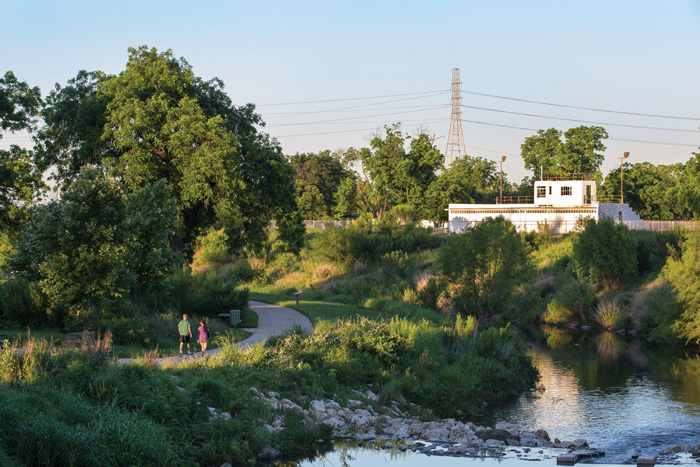
A view of the restored Mission Reach, where Wildflower Center ecological designers participated in the largest river restoration in the United States. PHOTO John W. Clark
But less than a year later, when Asher and a photographer returned to the Mission Reach, the two trudged through knee-high invasive spreading hedgeparsley (Torilis arvensis) and Queen Anne’s lace (Daucus carota) that obscured the native grasses and forbs.
Asher was disappointed, to say the least. Yet the reality in San Antonio is not, after all, uncommon; many landscape designers have had the experience of completing a project only to later see maintenance fail to uphold the integrity of original plans.
“The Mission Reach landscape is still attracting wildlife and helping prevent erosion on the riverbanks, even if it’s not functioning as purely as we imagined or at 100 percent yet,” he says. “Maintenance is a challenge inherent in creating living landscapes.”
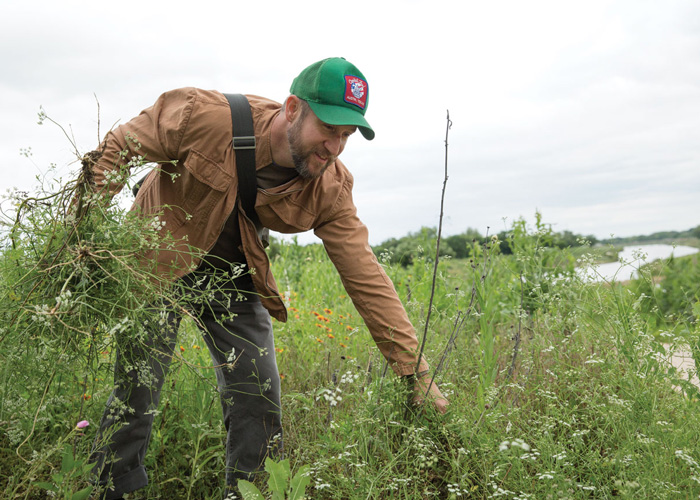
John Hart Asher removes spreading hedgeparsley at San Antonio’s Mission Reach. PHOTO John W. Clark
He continues to believe in the value of landscape design to create functioning ecosystems over the traditional path focused on aesthetics, quick establishment and cost.
“Eighty percent of the U.S. population now lives in urban areas, which have long been considered the antithesis of healthy and natural,” he says. “But that doesn’t have to be the case.”
By switching to the ecosystem approach, cities can enjoy a wide range of benefits collectively known as ecosystem services. These include enhanced beauty and recreational value, food and shelter for wildlife, stabilizing stream and river banks, filtering pollutants from water and air, sequestering carbon, and reducing the urban heat island effect – a phenomenon where cities experience higher temperatures than surrounding areas due to impermeable cover replacing open land and vegetation.
These functioning ecosystems can be created in both traditional settings, such as parks and roadsides, and novel ones, such as green roofs and rain gardens. A parking garage can become shady pollinator habitat, for example, and concrete stormwater culverts can be transformed to richly diverse wetlands. Make the switch in enough space and a city begins to function as an urban preserve.
A growing awareness of the value of ecosystem services is helping to drive a cultural shift toward designing urban landscapes with nature in mind, says Frederick Steiner, dean of The University of Texas at Austin School of Architecture and author of “Design for a Vulnerable Planet.” He says, “Awareness may be highest in cities feeling the increasing effects of climate change, such as drought and intense rainfall events.”
The high cost of traditional landscapes also drives the trend.
“While a natural system is very resilient and, over time, requires less maintenance, a synthetic system needs constant repair,” says Asher.
The constant repair of the country’s 20 million acres of residential lawns, for example, sucks up 30 to 60 percent of our urban water, $700 million worth of pesticides, $5.25 billion of fertilizer and 580 million gallons of gasoline each year. In addition to a cultural shift, change must also happen literally on the ground in the landscape maintenance and operations industry.
“Landscape maintenance right now is easy – mow and blow,” says Asher. “It is based on maintaining order and our cultural concept of aesthetics, without worrying about the health and function of a landscape. Here is a different way to do this.”
Changing the System
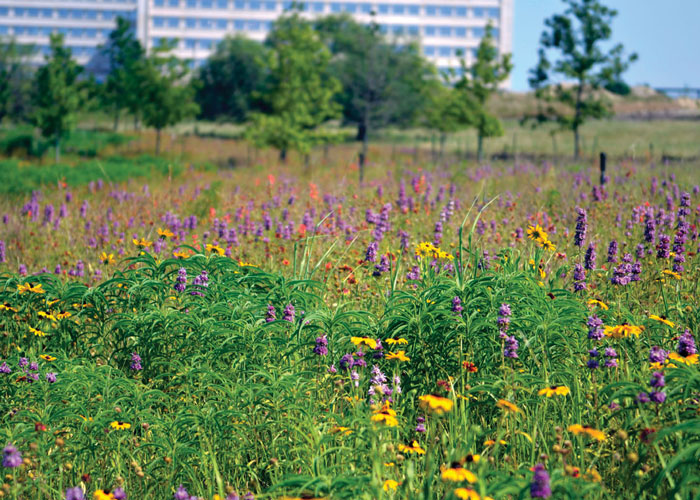
Center ecologists restored beauty to an area that is now Bluestem park at alliance town Center in Fort Worth. Black-eyed Susans (Rudbeckia hirta), purple horsemint (Monarda citriodora), Maximilian sunflower (Helianthus maximiliani) and standing cypress (Ipomopsis rubra) put on a show there this spring. PHOTO John Hart Asher
The landscape industry is set up to manage landscapes that reflect a pastoral aesthetic championed by Frederick Law Olmsted, the founding father of landscape architecture perhaps best known for designing New York City’s Central Park. Steiner says that aesthetic is often defined by clusters of trees and large green swaths, among other elements suited to the site.
Such landscapes are easy to maintain with lawnmowers, leaf blowers and hedge clippers. Managing natural landscapes, on the other hand, requires a different level of training and expertise.
Natural systems need an adaptive approach, with plans tailored for each individual site and its current stage.
“Each year, you’re going to need a different strategy,” says Wildflower Center environmental designer Michelle Bright. “There is no more, ‘on this date I mow and each year on this date, I trim the boxwood and fertilize the azalea.’ It may be that this year you need to remove invasive Johnson grass and fill in with native switchgrass.”
This idea of a constantly changing strategy can be daunting, and it also makes it harder to come up with a budget and staffing for maintenance.
“Mow and blow is a janitorial approach, not a relationship with the land,'” Asher adds. “Having a sustainable landscape means having to learn to read that landscape and know the seasons and climate. It means knowing when to plant things, versus installing plants on an artificial schedule because you have an irrigation system. Making the switch is more work up front, but the trend goes downward once you begin this relationship.”
Another hurdle is that natural landscapes need more time to establish and to look good than do traditional ones. That kind of patience is not necessarily built into our culture of immediate gratification; people who purchase landscaping want it looking good right away.
“We have to shift our understanding of beauty and the idea that you can install something over the weekend and it is good to go,” says Asher.
There are ways to work with this issue, Bright says, such as putting in some plants that grow quickly and look pretty right away. But part of the solution has to be education, first of those who commission landscape design and then those doing the maintenance long-term. That means bringing maintenance firms on board early in the process, and while that isn’t typical in the industry, she has seen it work.
“Once the landscape starts going in and the plants start coming up, the maintenance people get engaged,” she says. “On one project we worked on, a crew member who is out there pretty much every day told me that he couldn’t ask for a better job. He walks the site and comes up with a plan for the day, every day. People connect to the land and landscape in ways they wouldn’t with a more traditional design.”
As this kind of connection and awareness happens, people become more willing to try new things. They begin to understand ecological function and have higher expectations of the landscape. That might lead to adding certain plants based on pollinator benefits or those that put nutrients back in the soil, looking at how all the ingredients work together and creating a specific assemblage of plants for a particular site.
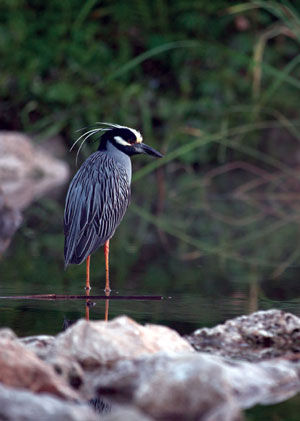
Wildlife like the yellow-crowned night heron benefit from the restoration of the San Antonio River at the Mission Reach. PHOTO John W. Clark
Of course, native materials attract a variety of critters, not just popular and harmless pollinators such as butterflies, Steiner warns. Ecosystem designers need to know which species are likely to show up and whether some of them might be considered undesirable.
“If you’re re-creating ecosystems, you are dealing with things besides the plants,” he explains. “You have to think in the bigger picture. For example, we need more flowers for bees so they can continue to pollinate our food supply. We want other species, too, but it requires being prepared and not surprised.”
Ecosystem designers and managers also must find ways to educate the users of landscapes and the general public.
“Otherwise, landscape managers may do something drastic like cut all the vegetation back when faced with a potential liability such as an increase in local wildlife,” Bright says.
It Takes a Village
Wild ecosystems function without much human interference and often are able to repair themselves after large disturbances, whereas urban ecosystems are challenged with much more extreme inputs. They are surrounded by degraded non-native landscapes, which makes them particularly subject to invasive plants, excessive storm run-off, overuse and other long-term maintenance issues.
At the Mission Reach, for example, invasive plants thrived in surrounding areas, just waiting to be brought in by wind, birds and other natural processes. Without ongoing, rigorous removal of those invaders, they were able to take over before the natives became well-established. Asher stresses that it isn’t too late to put things right on the Mission Reach, although it will take more work to remediate than it would have to keep ahead of invasives. To avoid a repeat of this scenario, landowners, maintenance firms and users all need to learn enough about a particular landscape to recognize invasive plants and commit to the ongoing problem-solving and effort needed to combat them.
One place that worked is Austin’s Mueller development, where the design group re-created 20 acres of short-grass prairie. The neighborhood association established a “Friends of the Prairie” group that marks invasives for the maintenance crew. Asher finds this pretty remarkable given that, in the beginning, residents didn’t know the difference between native silver bluestem and invasive Johnson grass.
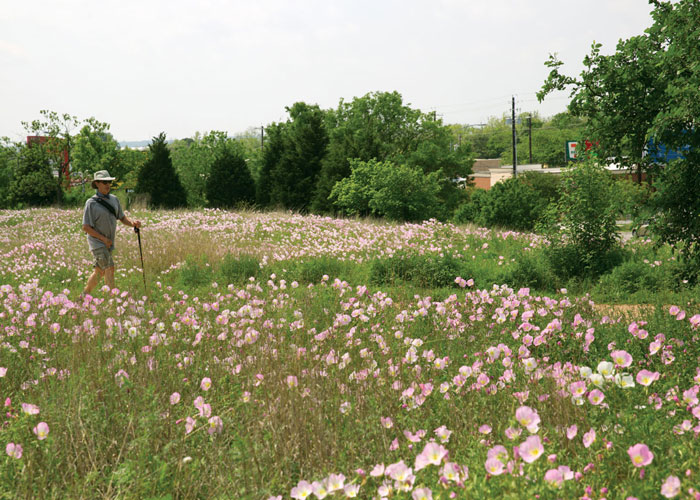
Evening primrose (Oenothera speciosa) flanks both sides of a trail at the Mueller Austin development. PHOTO John W. Clark
“This project blurs the traditional forms of landscape you expect to see in an urban area and is a good model to show that a developer can put in prairie and still be profitable,” says Asher. “It increased the value of the property and the health of residents, a positive for the city.”
The prairie has become a neighborhood amenity, a place where people love to come. Maintenance issues remain; for example, Asher would like to see crews staying more on top of invasives. Bringing nature to the city involves a lifetime commitment but in return offers a huge potential payoff.
“We can have a cumulative effect, which can be bad or good,” Asher sums up. “Look at Blackland prairie, which represents the most endangered ecosystem in the U.S., with less than 1 percent of it left. If we do enough projects, or get enough people to switch their yards over, we could create a functioning Blackland prairie right in the city. Austin could effectively be an ecological preserve.”
Melissa Gaskill covers travel, nature and science from Austin for many national and local publications and websites. This article originally appeared in the Winter 2015 issue of Wildflower magazine and includes a correction that more accurately reflects Dean Steiner’s comments about Olmsted.
Related Stories:
Make a Pocket Prairie
Mission Possible

